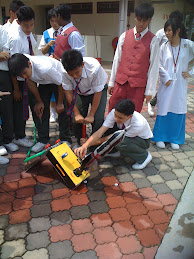Thursday, May 20, 2010
Sudut Sains : Maklumat 2010
A group of US paleontologists said Friday it has unearthed a new species of dinosaurs standing some six feet tall and weighing up to 4.5 tonnes, with the longest horns of all.
The 72-million-year-old herbivore, now named Coahuilaceratops magnacuerna, has two large horns above its eyes measuring up to an impressive four feet (1.22 meters) long -- the largest of any other species, providing fresh insight into the history of western North America.
Scientists uncovered fossils belonging to both an adult and a juvenile of the rhino-sized tubby creature at the Cerro del Pueblo Formation in Coahuila, Mexico. It measured about 22 feet (6.7 meters) long as an adult, standing six to seven feet (1.8 to two meters) tall at the shoulder and hips.
"We know very little about the dinosaurs of Mexico, and this find increases immeasurably our knowledge of the dinosaurs living in Mexico during the Late Cretaceous," said the study's lead author Mark Loewen, a paleontologist with the Utah Museum of Natural History.
His team is to release a book next week detailing the find, which took place during expeditions in 2002 and 2003 in the Coahuila desert. The study was funded by the National Geographic Society and the University of Utah.
When dinosaurs lived in this corner of Mexico, it was a lush, humid estuary where ocean water mixed with fresh water from rivers, similar to the US Gulf Coast today.
Many dinosaur bones unearthed in the area are covered with fossilized snails and marine clams, indicating that the creatures lived close to the seashore.
The rocks in which the paleontologists found Coahuilaceratops contained large fossil deposits of jumbled duck-bill dinosaur skeletons.
According to the scientists, the dinosaurs likely died en mass in the area due to storms similar to present-day hurricanes.
During most of the Late Cretaceous Period, 97 to 65 million years ago, high global sea levels led to flooding of the central, low-lying portion of North America.
Ultimately, a warm, shallow sea emerged, stretching from the Gulf of Mexico to the Arctic Ocean and splitting the continent into eastern and western landmasses.
"We are confident that Mexican dinosaurs will be a critical element in unravelling the ancient mystery of this island continent," said Scott Sampson of the Utah Museum of Natural History.
The end of the period also marks the extinction of dinosaurs after a massive six-mile (10-kilometer) long asteroid hit the Earth, according to the most widely accepted theory.
The impact is said to have lifted so much dust that the planet was plunged into darkness for several years, killing off a larger number of plants, followed by herbivores and carnivores.
Nearly 80 percent of the Earth's living species died as a result of the disaster.
The 72-million-year-old herbivore, now named Coahuilaceratops magnacuerna, has two large horns above its eyes measuring up to an impressive four feet (1.22 meters) long -- the largest of any other species, providing fresh insight into the history of western North America.
Scientists uncovered fossils belonging to both an adult and a juvenile of the rhino-sized tubby creature at the Cerro del Pueblo Formation in Coahuila, Mexico. It measured about 22 feet (6.7 meters) long as an adult, standing six to seven feet (1.8 to two meters) tall at the shoulder and hips.
"We know very little about the dinosaurs of Mexico, and this find increases immeasurably our knowledge of the dinosaurs living in Mexico during the Late Cretaceous," said the study's lead author Mark Loewen, a paleontologist with the Utah Museum of Natural History.
His team is to release a book next week detailing the find, which took place during expeditions in 2002 and 2003 in the Coahuila desert. The study was funded by the National Geographic Society and the University of Utah.
When dinosaurs lived in this corner of Mexico, it was a lush, humid estuary where ocean water mixed with fresh water from rivers, similar to the US Gulf Coast today.
Many dinosaur bones unearthed in the area are covered with fossilized snails and marine clams, indicating that the creatures lived close to the seashore.
The rocks in which the paleontologists found Coahuilaceratops contained large fossil deposits of jumbled duck-bill dinosaur skeletons.
According to the scientists, the dinosaurs likely died en mass in the area due to storms similar to present-day hurricanes.
During most of the Late Cretaceous Period, 97 to 65 million years ago, high global sea levels led to flooding of the central, low-lying portion of North America.
Ultimately, a warm, shallow sea emerged, stretching from the Gulf of Mexico to the Arctic Ocean and splitting the continent into eastern and western landmasses.
"We are confident that Mexican dinosaurs will be a critical element in unravelling the ancient mystery of this island continent," said Scott Sampson of the Utah Museum of Natural History.
The end of the period also marks the extinction of dinosaurs after a massive six-mile (10-kilometer) long asteroid hit the Earth, according to the most widely accepted theory.
The impact is said to have lifted so much dust that the planet was plunged into darkness for several years, killing off a larger number of plants, followed by herbivores and carnivores.
Nearly 80 percent of the Earth's living species died as a result of the disaster.
Sudut Fizik : Maklumat 2010
Bridges and other structures have a natural frequency that depends on their size and shape. If vibrations match this frequency, the bridge can vibrate wildly and even collapse.
If soldiers march in step across a bridge at the bridge's natural frequency, the magnified oscillations can break the bridge apart. This happened a couple of times in the 19th century, so now, soldiers break step when marching across a bridge.
The Tacoma Narrows bridge collapse in 1940, shortly after it was completed, is the most dramatic example of a resonating bridge collapsing. The bridge vibrated so much it was often called Galloping Gertie. Winds through the narrows vibrated the bridge at its natural frequency. Resonance amplified the vibrations until the bridge collapsed. Engineers now try to eliminate resonances when designing bridges.
Resonant phenomena occur often in nature. The effects can be either good, as in music, or bad, as in collapsing bridges.
If soldiers march in step across a bridge at the bridge's natural frequency, the magnified oscillations can break the bridge apart. This happened a couple of times in the 19th century, so now, soldiers break step when marching across a bridge.
The Tacoma Narrows bridge collapse in 1940, shortly after it was completed, is the most dramatic example of a resonating bridge collapsing. The bridge vibrated so much it was often called Galloping Gertie. Winds through the narrows vibrated the bridge at its natural frequency. Resonance amplified the vibrations until the bridge collapsed. Engineers now try to eliminate resonances when designing bridges.
Resonant phenomena occur often in nature. The effects can be either good, as in music, or bad, as in collapsing bridges.
Sudut Biologi : Maklumat 2010
An active compound from fungi and lower animals may well be suitable as an effective weapon against dangerous bacteria. We're talking about plectasin, a small protein molecule that can even destroy highly resistant bacteria . Researchers at the Universities of Bonn, Utrecht, Aalborg and of the Danish company Novozymes AS have shed light on how the substance does this. The authors see plectasin as a promising lead compound for new antibiotics.
Sudut Kimia : Maklumat 2010
he final interesting property that we shall deal with in this article is that ice floats. This should not happen because normally, when a liquid becomes a solid the solid is denser than the liquid and sinks. This is not the case in ice, because of the hydrogen bonds. In liquid the hydrogen bonds are being made and broken constantly. In ice, however, the water molecules form a regular structure based on the hydrogen ions, and they are held slightly further apart than has been the case in the liquid. This makes ice less dense and floats. One interesting result of this property can be seen in ponds and lakes. Ice forms on the surface and the densest water at the bottom of the pond is at 4 degrees centigrade, so fish and other water dwellers are not frozen to death.
These properties of water make it so useful to life. We need water to be a liquid at room temperature because many of the bodies systems are water based. We need water to be a polar solvent, so that the important nutrients we need can be dissolved in it.
These properties of water make it so useful to life. We need water to be a liquid at room temperature because many of the bodies systems are water based. We need water to be a polar solvent, so that the important nutrients we need can be dissolved in it.
Pertandingan-Pertandingan Sains 2010
Naib Johan Kuiz Sains Menengah Rendah
Sekolah kita telah muncul sebagai Naib Johan acara individu dan Naib Johan acara berkumpulan.
Pertandingan ini dianjurkan oleh Persatuan Sains dan Matematik Sek Men Keb Gajah Berang.
Naib Johan Individu : Ahmad Muzamill Azeem

Naib Johan Berkumpulan : Ahmad Muzamill Azeem

Naib Johan Berkumpulan : Grace Lim Pei Ling

Naib Johan Berkumpulan : Izzatee Sofia Mohd Khairi



Sekolah kita telah muncul sebagai Naib Johan acara individu dan Naib Johan acara berkumpulan.
Pertandingan ini dianjurkan oleh Persatuan Sains dan Matematik Sek Men Keb Gajah Berang.
Naib Johan Individu : Ahmad Muzamill Azeem

Naib Johan Berkumpulan : Ahmad Muzamill Azeem

Naib Johan Berkumpulan : Grace Lim Pei Ling

Naib Johan Berkumpulan : Izzatee Sofia Mohd Khairi



Aktiviti-aktiviti Panitia Sains 2010
1. Mesyuarat Panitia
2. Kelas tambahan
3. Kelas Tutorial
4. Klinik Sains
5. Pertandingan Sains
6. Ceramah teknik menjawab soalan
7. Minggu Sains
8. Ujian dan Peperiksaan
9. Program Perkembangan Staf
10.Program Penyeliaan
2. Kelas tambahan
3. Kelas Tutorial
4. Klinik Sains
5. Pertandingan Sains
6. Ceramah teknik menjawab soalan
7. Minggu Sains
8. Ujian dan Peperiksaan
9. Program Perkembangan Staf
10.Program Penyeliaan
Ahli-ahli Panitia Sains 2010
En. Rahmat Galim : GPK 1
Pn. Rohila Ibrahim : GKMP Sains
En. Peh Tze Koon : Ketua Panitia Sains dan Guru Cemerlang Fizik
Pn. Rosezelenda Abd Rahman : Guru Cemerlang Sains
Pn. Khatijah Yasim : Guru Fizik
Pn. Anizawati Zainal : Guru Biologi
Pn. Nur Radziah Salim : Guru Kimia
En. Hasbullah Md Sukur : Guru Sains
Pn. Norhara Ahmad : Guru Sains
Pn. Rohila Ibrahim : GKMP Sains
En. Peh Tze Koon : Ketua Panitia Sains dan Guru Cemerlang Fizik
Pn. Rosezelenda Abd Rahman : Guru Cemerlang Sains
Pn. Khatijah Yasim : Guru Fizik
Pn. Anizawati Zainal : Guru Biologi
Pn. Nur Radziah Salim : Guru Kimia
En. Hasbullah Md Sukur : Guru Sains
Pn. Norhara Ahmad : Guru Sains
Misi Panitia Sains 2010
Subscribe to:
Posts (Atom)
.jpg)
.jpg)
.jpg)
.jpg)
.jpg)
.jpg)
.jpg)






.jpg)



.jpg)






